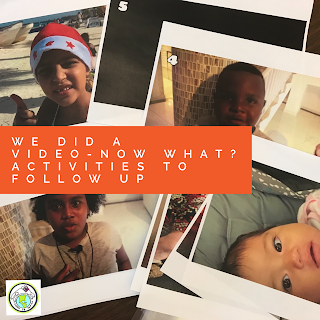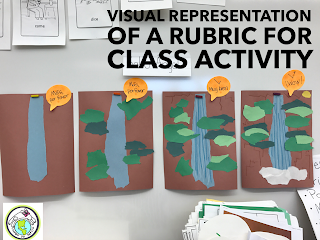1) DO A VENN DIAGRAM: You may already know that I LOVE Venn Diagrams; they are so simple and easily accessible for novice speakers, and have the additional benefit of a math concept (compare & contrast). Since I frequently connect my mini books with videos, it is a natural extension to compare the two. You can do a whole class Venn diagram using hula hoops (I borrow from our Phys Ed teacher) and story props from the theme along with cut outs from the video (I usually do a search on Pinterest for images related to the video) or you can have kids complete individual Venn diagrams on paper. Here is a video of a Venn I did with my Kinders using our mini book 'Julieta y Mateo hacen un picnic' and a Peppa Pig video:
Link to our Theme Pack 'Julieta y Mateo hacen un picnic'
Here is a Venn I did with my multiage class after reading our mini book 'Arriba' and viewing another Peppa Pig video, el Viaje en globo-since these classes are made up of Kindergartners, 1st and 2nd graders, I instructed them to illustrate, rather than write, what each character sees during her trip; as they are illustrating, I circulate and ask what they are drawing, either with yes/no questions, either/or or open ended depending on their level.
 |
| Click here to grab our Theme Pack 'Arriba' |
3) FOUR CORNERS with screen shots... this is an easy prep activity that involves taking screen shots of various scenes from the video, then using them as the images in FOUR CORNERS (click here for my post on how to play if unfamiliar). I like this a lot as it allows me to use longer chunks and/or full sentences as the listening prompt, rather than just a single word. The images in the photo below are from Cantoalegre's Lolalá episode 10 which I use during my 'Olivia en la granja' theme ..I love that the images from this particular video allow me to reinforce listening comprehension for 'sees', 'looks for', and 'finds', all verbs we use again and again.
4) SEQUENCE THE SCENES with screen shots...again, a simple activity to prep. Take a series of screen shots from the video, mix them up, and following viewing the video, have kids put the scenes back in order according to the video. Here is one of my First grade classes ordering scenes from a video on how to make chocolate -note how simple I keep the activity to make it accessible to my Novice Low students, including the use of number cards to further convey the task:
5) WAS THERE A ___ IN THE VIDEO? For a simple follow up to a video, compile a set of cards with vocabulary words on them, some of which are things that were in the video and some that were not. I like to do this as a contest-I go around the room, one kid at a time, pull a card and ask him or her if what the card says was in the video, yes or no. (For ex, Was there a house in the video, yes or no?). If they get it right, the class gets a point; if they get it wrong, I get a point. Since they usually get most right, I get very few points, to the immense delight of my students!!
6) WORD-IMAGE MATCH: There are a variety of ways you can do this, adjusting for proficiency level of your students-from a one word or word chunk match to a screen shot, to a longer sentences matched to a screen shot. Provide a set of screen shots that reinforce the key vocabulary you are focusing on, along with word or word chunk cards or sentence strips which students then read and match to the correct screen shot, such as in the photo below, featuring an authentic video from Colombia and word cards from our Granja Theme Pack, which you can find here.
What follow up activities do you do with a video? Please share in the comments below!











